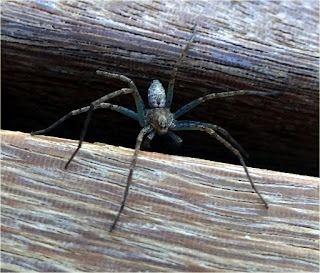Murielle Leroy very kindly sent me these Photographs from her trip to
Corsica in July, 2010
Argiope lobata
Family -
Araneidae
Genus -
Argiope
Male - 6mm / Female - upto 25mm
Known as the Lobed Argiope.
Quite a large Orb Weaving Spider found all over Africa and stretching
to Southern Europe and into Asia.
Distinctive zig-zag pattern/ ribboning (stabilimenta) emanating from the centre
of the Orb Web, thought to be a disguise from predators by camouflaging the
Spider or making it appear larger.
A relative of the UK's
Wasp Spider - Argiope bruennichi.


Female.
Murielle told me that her friend who is responsible for Species Recording
at the Nature Reserve had never seen this Spider there before.
"Le sentier des Bruzzi" : "The footpath of the Bruzzi"
Réserve Naturelle des Bouches de Bonifacio
South Corsica
Photo's by Murielle Leroy
July 2010
::::::::
The European or Mediterranean Black Widow Spider - Malmignatte
Latrodectus tredecimguttatus
Family -
Theridiidae
Genus -
Latrodectus
Identified by the distinctive 13 Spots on the Abdomen.
The Species name is Latin for 'with 13 Spots'
.
Females have a painful bite but rarely fatal.
Female Juvenile. All Black when Adult. 10-15mm (Females)
Photograph by Candice Durand.
The Spider was found in her young Son's shoe!
Pianottoli-Caldarello Village
South Corsica
August 2010
Here is an excerpt from The Life of The Spider by
Jean Henri Fabre 1912,
in which he writes of the Malmignatte:
' ..the Malmignatte, the terror of the Corsican peasantry. I have seen her
settle in furrows, lay out her web and rush boldly at insects larger than
herself; I have admired her garb of black velvet speckled with carmine red;
above all, I have heard most disquieting stories told about her. Around Ajaccio
and Bonifacio, her bite is reputed very dangerous, sometimes mortal. The
countryman declares this for a fact and the doctor does not always dare deny
it.'
Murielle informs me that even though this was written 100 years ago, the
locals still think this way.
Origin of Malmignatte: It
malmignatta, fr.
mal,
malo bad (fr. L
malus) +
mignatta leech.
(Source -
http://www.merriam-webster.com/dictionary/malmignatte)
::::::::

This Crab Spider seems spoilt for choice, or outnumbered!
Photographs by Candice Durand.
Pianottoli-Caldarello
South Corsica
25.04.12
Synaema globosum
Family:
Thomisidae
Genus :
Synaema
Pianottoli
South Corsica
28.04.12
Photographs and Id by Candice Durand.
False Widow -
Steatoda nobilis
Family:
Theridiidae
Genus:
Steatoda
Pianottoli
South Corsica
29.04.12
Photographs by Candice Durand.
A Jumping Spider - Salticidae
Heliophanus sp.
Heliophanus lineiventris (?)
Pianottoli
South Corsica
11.05.12
Photograph by Candice Durand.
Juvenile

I think these Spiders are
Clubiona sp.
Family :
Clubionidae
 Steatoda triangulata
Steatoda triangulata
Family :
Theridiidae
Genus :
Steatoda
A member of the family known as False Widow Spiders. They are thought to
have originated from Eurasia
.
Harvestman -
Opiliones
Relatives of Spiders
 Holocnemus pluchei
Holocnemus pluchei
Family :
Pholcidae
Known as the Marbled Cellar Spider.
I think a type of Money Spider -
Linyphiidae.
Impressive Palps on this Male!
Pianottoli
South Corsica
17.05.12
Photographs by Candice Durand.

 Drassodes sp.
Gnaphosidae
Pianottoli
Drassodes sp.
Gnaphosidae
Pianottoli
South Corsica
19.05.12
Photographs by Candice Durand.
Red Backed Jumping Spider
Phidippus sp.
Salticidae
Pianottoli
South Corsica
25.05.12
Photograph by Candice Durand.

Juvenile Male Running Crab Spider
Philodromus sp
Philodromidae
31.05.12
Spiderlings - I don't know which Species.
Pianottoli
South Corsica
03.06.12
Photographs by Candice Durand.

Male Labyrinth Spider
Agelena labyrinthica
Agelenidae
Pianottoli
South Corsica
04.06.12
Photographs by Jacquet Lorenzo (Aged 10 years).


Jumping Spider -
Salticidae
Female
Philaeus chrysops (?)
Candice tells me, the Spider jumped at her Lens and then shied away from
her camera
.
Pianottoli
South Corsica
05.06.12
Photographs by Candice Durand.


A type of Orb Weaver.
Pianottoli
South Corsica
14.06.12
Photographs by Jacquet Lorenzo (Aged 10 years).
I think this is
Agaleneata redii
Family :
Araneidae
Genus :
Agaleneata
Pianottoli
South Corsica
14.06.12
Photographs by Jacquet Lorenzo (Aged 10 years).
I think this is
Hogna radiata
Family:
Lycosidae
Genus :
Hogna
Pianottoli
South Corsica
15.06.12
Photographs by Candice Durand.
Holocnemus pluchei with Eggs
Family :
Pholcidae
Pianottoli
South Corsica
07.07.12
Photographs by Candice Durand.

I think this is
Hogna radiata
Family:
Lycosidae
Genus :
Hogna
 Araneus diadematus
Pianottoli
Araneus diadematus
Pianottoli
South Corsica
21.07.12
Photographs by Candice Durand.
I think this is
Hogna radiata
Family:
Lycosidae
Genus :
Hogna
Pianottoli
South Corsica
23.07.12
Photographs by Candice Durand.
Female carrying Spiderlings
I think this is
Hogna radiata
Family:
Lycosidae
Genus :
Hogna
Photographs by Julien Girard
Figari, South Corsica
09.09.12
Jumping Spider
Salticidae
Photographs by Lorenzo
03.10.12
Thomisus onustus
Family :
Thomisidae
Genus :
Thomisus
Photograph by Julien Girard
Figari, South Corsica
09.09.12
Holocnemus pluchei
Family :
Pholcidae
Known as the Marbled Cellar Spider.
 Agelena labyrinthica
Agelena labyrinthica
Family :
Agelenidae
Photo's by Candice Durand
Pianottoli, South Corsica
19.09.12











































































































